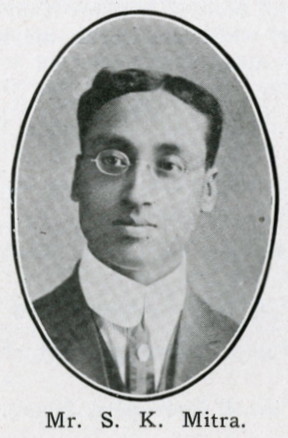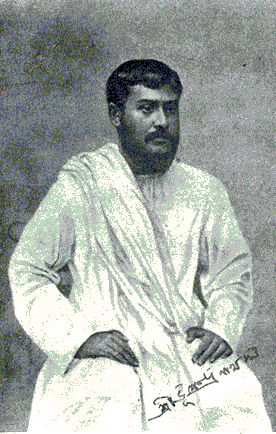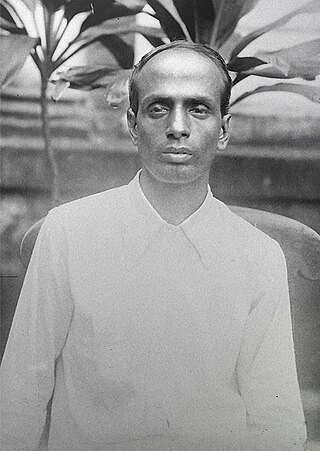Related Research Articles

Syama Prasad Mukherjee was an Indian politician, barrister and academician, who served as India's first Minister for Industry and Supply in Jawaharlal Nehru's cabinet. After falling out with Nehru, protesting against the Liaquat-Nehru Pact, Mukherjee resigned from Nehru's cabinet. With the help of the Rashtriya Swayamsevak Sangh, he founded the Bharatiya Jana Sangh, the predecessor to the Bharatiya Janata Party, in 1951.

Bankim Chandra Chattopadhyay CIE was an Indian novelist, poet, essayist and journalist. He was the author of the 1882 Bengali language novel Anandamath, which is one of the landmarks of modern Bengali and Indian literature. He was the composer of Vande Mataram, written in highly sanskritized Bengali, personifying Bengal as a mother goddess and inspiring activists during the Indian Independence Movement. Chattopadhayay wrote fourteen novels and many serious, serio-comic, satirical, scientific and critical treatises in Bengali. He is known as Sahitya Samrat in Bengali.
Sir Ashutosh Mukherjee was a prolific Bengali educator, jurist, barrister and mathematician. He was the first student to be awarded a dual degree from Calcutta University. Perhaps the most emphatic figure of Indian education, he was a man of great personality, high self-respect, courage and towering administrative ability. The second Indian Vice-Chancellor of the University of Calcutta for four consecutive two-year terms (1906–1914) and a fifth two-year term (1921–23), Mukherjee was responsible for the foundation of the Bengal Technical Institute in 1906, which was later known as Jadavpur University and the University College of Science of the Calcutta University in 1914.
Bengali Brahmos are those who adhere to Brahmoism, the philosophy of Brahmo Samaj which was founded by Raja Rammohan Roy. A recent publication describes the disproportionate influence of Brahmos on India's development post-19th Century as unparalleled in recent times.
The Young Bengal was a group of Bengali free thinkers emerging from Hindu College, Calcutta. They were also known as Derozians, after their firebrand teacher at Hindu College, Henry Louis Vivian Derozio.

Sir Acharya Prafulla Chandra Ray, CIE, FNI, FRASB, FIAS, FCS was an Indian chemist, educationist, historian, industrialist and philanthropist. He established the first modern Indian research school in chemistry and is regarded as the Father of Indian Chemistry.

The Bengal Renaissance, also known as the Bengali Renaissance, was a cultural, social, intellectual, and artistic movement that took place in the Bengal region of the British Raj, from the late 18th century to the early 20th century. Historians have traced the beginnings of the movement to the victory of the British East India Company at the 1757 Battle of Plassey, as well as the works of reformer Raja Rammohan Roy, considered the "Father of the Bengal Renaissance," born in 1772. Nitish Sengupta stated that the movement "can be said to have … ended with Rabindranath Tagore," Asia's first Nobel laureate.

Sisir Kumar Mitra MBE, FNI, FASB, FIAS, FRS was an Indian physicist.

Anushilan Samiti was an Indian fitness club, which was actually used as an underground society for anti-British revolutionaries. In the first quarter of the 20th century it supported revolutionary violence as the means for ending British rule in India. The organisation arose from a conglomeration of local youth groups and gyms (akhara) in Bengal in 1902. It had two prominent, somewhat independent, arms in East and West Bengal, Dhaka Anushilan Samiti, and the Jugantar group.

Prasanna Kumar Roy was an educationist and the first Indian principal of Presidency College, Kolkata.
Satish Chandra Mukherjee was a pioneer in establishing a system of national education in India, along with Sri Aurobindo.

Ajoy Kumar Mukherjee was an Indian independence activist and politician who served three short terms as the fourth and sixth Chief Minister of West Bengal. He hailed from Tamluk, Purba Medinipur district, West Bengal.

Bhupendranath Datta was an Indian communist revolutionary and later a noted sociologist and anthropologist. He associated Rishi Aurobindo in his political works. In his youth, he was closely associated with the Jugantar movement, serving as the editor of Jugantar Patrika until his arrest and imprisonment in 1907. In his later revolutionary career, he was privy to the Indo-German Conspiracy. His elder brother was Swami Vivekananda. The Asiatic Society today holds the Dr. Bhupendranath Datta memorial lecture in his honour.
The first Christmas Day plot was a conspiracy made by the Indian revolutionary movement in 1909: during the year-ending holidays, the Governor of Bengal organised at his residence a ball in the presence of the Viceroy, the Commander-in-Chief and all the high-ranking officers and officials of the Capital (Calcutta). The 10th Jat Regiment was in charge of the security. Indoctrinated by Jatindranath Mukherjee, its soldiers decided to blow up the ballroom and take advantage of destroying the colonial Government. In keeping with his predecessor Otto von Klemm, a friend of Lokmanya Tilak, on 6 February 1910, M. Arsenyev, the Russian Consul-General, wrote to St Petersburg that it had been intended to "arouse in the country a general perturbation of minds and, thereby, afford the revolutionaries an opportunity to take the power in their hands." According to R. C. Majumdar, "The police had suspected nothing and it is hard to say what the outcome would have been had the soldiers not been betrayed by one of their comrades who informed the authorities about the impending coup".

Surya Sen, also called Surya Kumar Sen, was an Indian revolutionary who was influential in the independence movement against British rule in India and is best known for leading the 1930 Chittagong armoury raid.

Jnanendra Nath Mukherjee CBE, FRSC was an Indian colloid chemist.
The history of the Anushilan Samiti stretches from its beginning in 1902 to 1930. The Samiti began in the first decade of the 20th century in Calcutta as conglomeration of local youth groups and gyms(Akhra). However, its focus was both physical education and proposed moral development of its members. From its inception it sought to promote what it perceived as Indian values and to focus on Indian sports e.g. Lathi and Sword play. It also encouraged its members to study Indian history as well as those of European liberalism including the French Revolution, Russian Nihilism and Italian unification. Soon after its inception it became a radical organisation that sought to end British Raj in India through revolutionary violence. After World War I, it declined steadily as its members identified closely with leftist ideologies and with the Indian National Congress. It briefly rose to prominence in the late second and third decade, being involved in some notable incidents in Calcutta, Chittagong and in the United Provinces. The samiti dissolved into the Revolutionary Socialist Party in 1930.
The National Council of Education - Bengal was an organisation founded by Satish Chandra Mukherjee and other Indian nationalists in Bengal in 1906 to promote science and technology as part of a swadeshi industrialisation movement. It established the Bengal National College and Bengal Technical Institute which would later merge to form Jadavpur University. Institutions which were functioning under the council were considered to be hotbeds of swadeshi activities and the government banned nationalistic activities such as the singing of patriotic songs.
Dawn was an English-language magazine launched in 1897 by Indian Bengali educationalist Satish Chandra Mukherjee. The magazine arose at a time of growing nationalism in India and particularly Bengal in the last part of the 19th century, and propagated Mukherjee's views on national education in the context of the emerging nationalist movement in India, and promoted Mukherjee's message of recalling India's cultural and philosophical heritage. The magazine achieved widespread circulation by early 1900s, and particularly criticised the movement towards colonial domination of institutes of higher education that became ratified in the Universities bill, 1904. The magazine was considered a journal of high standard and taste amongst Bengali intelligentsia. The magazine went on to lend its name to a society that arose from a conglomeration of Bengali intellectuals and eminent scientists who contributed to the magazine, and articles appeared on various subjects including Science, technology and similar subjects focussed on the needs in the society. The magazine was published monthly, in English. Each number of the journal was divided into three parts. Lal Mohan Mullick served as the publisher, Mukherjee contributed as editor in a number of Science-themed articles, and in a dedicated column entitled Indiana, he wrote on many aspects of Indian civilisation.
Gandhi Memorial Asram popularly known as Sodepur Khadi Ashram is a heritage institution of Sodepur, Panihati, North 24 Parganas in the Indian state of West Bengal.
References
- ↑ "Dawn Society, The". Banglapedia. Retrieved 1 December 2017.
- South Asia Archive on Dawn magazine and Dawn society
- Land of Two Rivers: A History of Bengal from the Mahabharata to Mujib. Nitish K. Sengupta. 2011. Penguin Books India. p303